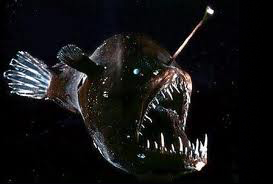
Ceratioid Anglerfish Mating: Sexual Dimorphism and Parasitism
| Home |
| Mechanism |
| Ontogeny |
| Phylogeny |
| Adaptive Value |
| References |
Phylogeny
Distribution of Parasitism in Anglerfish
Permanently-attached males have only been observed in 5 of the 11 ceratioid families (10 out of 35 genera, 23 out of 160 known species). All other ceratioid groups undergo somewhat similar behaviors, but the males are either facultative parasites or only attach temporarily during mating. In more distantly-related groups of anglerfish, the males never attach to the females, making the parasitic or semi-parasitic reproductive relationship unique to ceratioids (Vollrath 1998, Pietsch 2005).
Evolution of Sexual Parasitism: Morphological Evidence
Before molecular data had been used to construct anglerfish phylogenies, relationships were assigned using morphological observations (and, at that, almost exclusively female morphologies, since males are smaller and harder to find). Based solely on morphological data, the suborder Ceratioidei (ceratioids, all of which have somewhat parasitic behaviors; see above) was believed to be monophyletic due to the following highly-conserved features of all species (Pietsch 2005, Dettai et al 2004):
- extreme sexual dimorphism
- loss of pelvic fins
- repositioning of pectoral fins
- reduced density due to loss of bony parts
- decrease in ossification, extensive muscle development
- infusion of lipids throughout the body.
Morphological data suggests multiple independent evolutoions of obligate parasitism rather than repeated loss, as the nature of male-female attachment varies among parasitic taxa. (Miya et al. 2010)
Evolution of Sexual Parasitism: Molecular Evidence
While previous molecular studies were inconclusive in determining taxonomic relationships between anglerfish groups (e.g., Halcroft 2004, 2005), new phylogenies generated from maximum likelihood (ML) organization of mitogenomic information for ceratioids and some other related groups indicate that parasitic behavior (temporary male attachment or facultative or obligate parasitism) is monophyletic within the suborder (Yamanoue et al. 2007, Miya et al. 2010). However, the group of obligate reproductive parasites within ceratioids was shown to be paraphyletic. In other words, current molecular evidence suggests that obligate parasitism evolved multiple (at least three and as many as five) times in ceratioids, rather than having evolved once and then lost repeatedly by other species. (Shedlock et al. 2004, Pietsch 2005, Carnevale et al. 2008, Miya et al. 2010) The ML molecular reconstruction of the phylogenetic relatioships also suggests that temporary attachment to females was a precursor to facultative and obligate parasitism, rather than a reduction of an ancestral parasitic behavior (Chen et al. 2003, Holcroft et al. 2004, Miya et al. 2010 - see figure below).

Lauren Carley, Jessie Ellington, Michael Turvey. 2010.